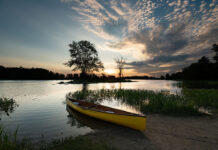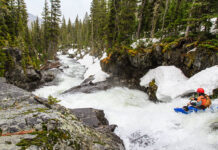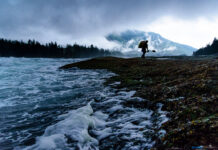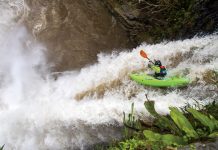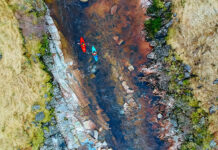There’s no better way to get on the water and get away from it all than in a canoe. Canoeing is simple, efficient and has a relatively low barrier to entry. Once you have the basics down, you can go just about anywhere.
This article will go over the basic questions you might have when learning how to canoe. Like learning most things, however, reading about something is much different than doing it. Taking a lesson from a qualified instructor can make the learning process go more smoothly and will help give you confidence on the water.
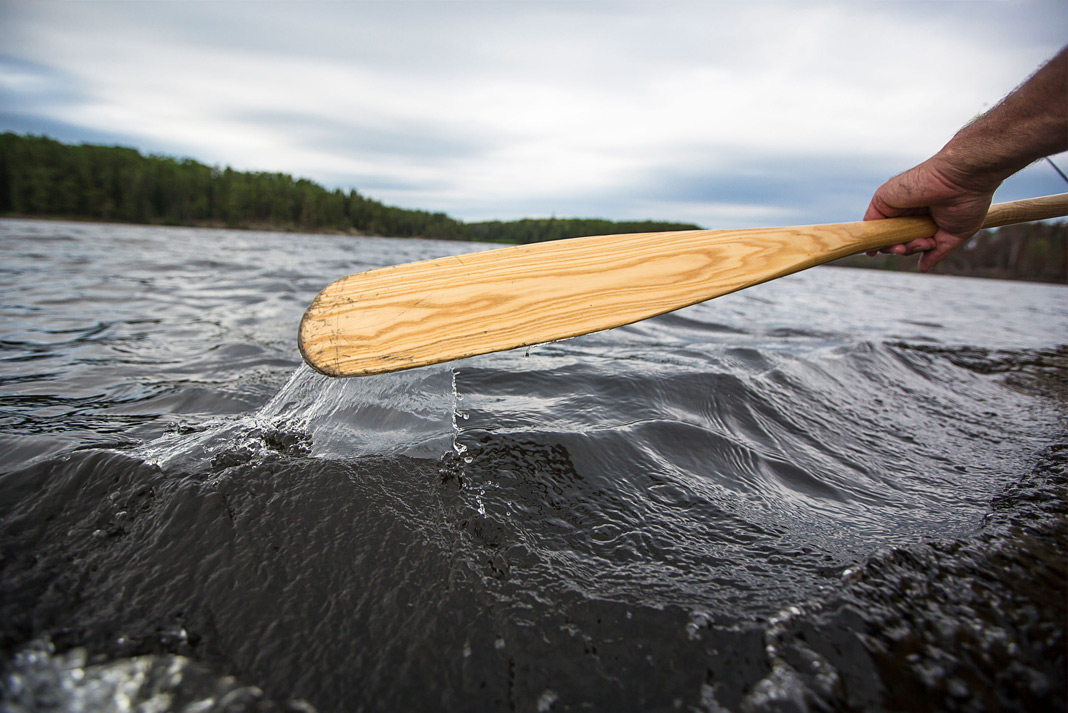
How to launch a canoe
Where to sit in a canoe
Before you just jump into a canoe all willy-nilly, there are some things you should have figured out, like where the bow (front) of the boat is and where the stern (back) is. You should also figure out who’s sitting where. The easiest way to figure out where the bow of the boat is, is to look at the seats. The end that has the larger space between the end of the boat and the seat is the bow—if you try to sit in the rear seat as a front seat, you’ll see the issue very quickly as there won’t be much room for your legs.
The majority of steering comes from the stern of the boat, so between you and your partner, you should probably put the more experienced paddler in the stern. In an ideal situation, the heavier of the two paddlers should be in the rear, but paddling experience can override this rule.
If you’re paddling solo, you’ll want to move forward in the boat. You want your weight somewhere closer to the middle of the boat, so the bow isn’t in the air being blown around by the wind. If you have a symmetrical canoe—which means the bow is the same shape as the stern—you can sit backwards on the bow seat and paddle the canoe “backwards.” This is sufficient to get your weight farther forward in the boat. Other times, you’ll need to sit closer to the yoke (centered on the canoe). It will depend on conditions and the boat itself.
How to get into a canoe
Canoes are pretty stable once you’re in them, but it’s getting into them some people find tricky; that’s because while stepping in, your center of gravity is high. The lower you can get it to the bottom of the canoe, the more stable the boat becomes.
If you’re launching from a beach, it’s best to sit the canoe perpendicular to the shore. With the bow of the boat in the water, one person can stabilize the canoe from the stern as it rests on shore, while the bow paddler walks in the canoe up to the bow seat. Be sure to stay low and use the gunwales for support, with your feet close to the center line of the boat, then sit down. Once the bow paddler is seated, the stern paddler can push the boat until it floats, then step carefully into the boat and onto the stern seat.
Getting in a canoe from a dock or rocky shoreline is a little more difficult, but still quite easy if you are careful and methodical in your movements. Position the canoe parallel to the dock or shore. One person stabilizes the boat while the other steps into the canoe. While stepping in, remember to stay low. As you step in, remember to step into the center of the canoe one foot at a time.
If you’re doing either of these launches as a solo paddler, the actions are similar, but you don’t have the partner to stabilize for you. Be sure to reach to the far gunwale to help equalize your weight before stepping in and step one foot at a time into the center of the boat. It’s helpful to enter near the stern of the boat, where it’s narrower, and then move forward.
How do I get out of a canoe?
Getting out of a boat on a shallow beach is the same process as getting in, only in reverse. Paddle the boat into shore, perpendicular to the shoreline. The bow person steps out of the boat and stabilizes it for the stern paddler who, in turn, walks to the front of the boat, then steps out in the shallower water.
Getting out of a boat on a dock or rocky shoreline is also the reverse of getting in. One partner will stabilize the boat by grabbing the dock, while the other will stand up slowly with their hands on the gunwales and feet in the center of the boat. That person will step from the boat to the dock carefully and methodically. Then they’ll stabilize the boat while their partner exits.
As a solo paddler, you’ll need to stabilize the boat by grabbing the outer gunwale and the dock, slowly stand to a crouched position in the center of the boat, and then carefully step up and onto the dock.
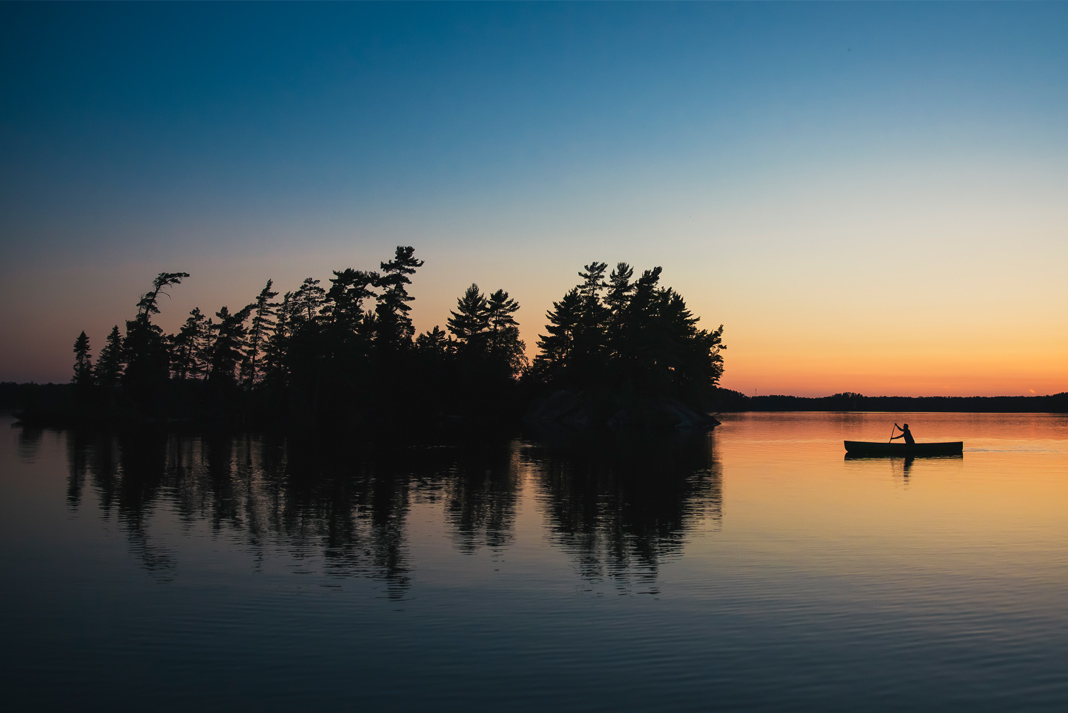
Kneeling vs. sitting
Kneeling and sitting are about your only two options while in a canoe. And while sitting is the more comfortable of the two options, it isn’t always the best choice. Here’s why. When you’re sitting in a canoe, your center of gravity goes onto the seats, so it’s considerably higher than if you are kneeling. When you’re kneeling, your weight is on the bottom of the boat, essentially below the waterline. The higher your center of gravity is, the more likely you are to tip.
That said, few canoeists (probably only the ones on younger knees) can kneel all day. It’s okay to switch from one to the other during a long paddle; just remember that everything is more stable if you’re kneeling, so when you see some waves or technical paddling coming up, drop to your knees for an action stance.
It’s an easy DIY project to add kneeling pads to your paddling stations.
How to not tip a canoe
If you’re concerned about tipping your canoe, you’ll need to spend some time in one to get over the fear. Canoes are surprisingly stable once you’re in them. Time spent in the boat will quickly reassure you that this isn’t some circus balancing act. Anyone can balance a canoe.
Follow these simple tips and you’ll have no trouble keeping your canoe upright. First, as stated above, kneel on the floor of the canoe, as this is the stablest position. Once you gain some confidence, you can sit on the seats and maintain stability. But it’s best to kneel if you feel nervous. From there, recall the old saying “loose hips save ships” (or something like that…), meaning if the boat tips one way, you want your core and upper body to remain upright and perpendicular to the waterline. Staying loose in your hips and relaxing will help ensure your canoe doesn’t tip.
How to paddle a canoe
How to hold a canoe paddle
To properly hold a canoe paddle, you want one hand on the top grip—also called the butt of the paddle—and the other hand on the shaft, closer to the paddle’s blade. The butt end of the paddle will be shaped to fit your palm, while your bottom hand should grasp the shaft thumb-side up. If you’re paddling on the left side of the boat, your right hand will be on top of the paddle; if you’re paddling on the right side, your left hand will be on top.
How to paddle forward
With your hands in the proper position and with a slight bend in your elbows, rotate your torso in the direction of your top hand. Plant your paddle blade in the water, then punch your grip hand forward and down, creating a lever with your lower hand, while rotating your torso to put some bodyweight behind the punch. Your lower hand will guide the blade back, along the side of the canoe. Once the blade has passed your hip, slice it out of the water and return to your starting position.
Remember to keep the paddle vertical in the water—you want your grip hand to be out over the water. This technique harnesses the large and powerful muscles of your core versus the comparatively weak ones in your arms and shoulders. If your arms start to feel tired, it’s usually a sign you’re not employing the proper technique.
The most efficient way to paddle forward is for both canoeists to paddle in sync. This means the stern paddler will need to match the cadence of the bow paddler’s strokes, and the bow paddler will need to do their best to make smooth, consistent strokes. Paddlers should paddle on opposite sides of the canoe and communicate when they want to switch sides.
How to paddle backward
Guess what? Paddling backward is just like paddling forward, only in reverse. Why would you want to paddle backward? All kinds of reasons. Maybe you want to avoid something downstream. Maybe you just want to go backward for a bit. Give it a try and have it in your back pocket as yet another paddling skill.
How to steer a canoe
Steering a canoe is pretty easy once you have the right techniques dialed. As stated above, the stern paddler is mostly responsible for steering the canoe. The way many first-time canoeists will steer a canoe is by simply switching which side of the boat they are paddling on. After all, more strokes on one side of the boat will turn the boat in the other direction. However, this isn’t a very efficient way of steering your canoe.
The first stroke you’ll want to learn is the J-stroke. This stroke is useful for both keeping your canoe on course and turning. If you and your canoeing partner are paddling on opposite sides of the boat in sync, in theory this should mean your canoe will travel in a straight line. However, if the stern paddler is stronger than the bow paddler, after every few strokes the canoe may start to turn away from the side the stern paddler is paddling on. Instead of switching sides to correct the direction of the boat, the stern paddler can use the J-stroke. The basics of this stroke are outlined here: Expert Canoeing Advice: How To Do The J-Stroke.
In essence, the J-stroke involves beginning a normal forward paddle stroke and then turning the power-face (the side of the blade facing the back of the canoe) away from the canoe. The easiest way to do this is to rotate the hand holding the top of the paddle so the thumb is pointing down. The blade can then be pried out away from the boat, depending on how much of a correction needs to be made.
The J-stroke can also be used to turn the canoe in a new direction. If the stern paddler is paddling on the left side of the canoe, the J-stroke will enable them to turn the canoe to the left. In this situation, if the stern paddler wished to turn the canoe to the right, in theory they could switch sides and perform the J-stroke on the right side of the boat. A much easier technique, however, is to perform a sweep stroke.
The sweep stroke is often used by solo paddlers, but a partial sweep stroke can also be useful to tandem paddlers. The stern paddler will plant their paddle out 90 degrees from their body and, using their core strength, will draw the paddle back in an arc through the water until it reaches the back of the boat. This will turn the boat away from the side the stern paddler is paddling on.
How to move your canoe sideways
By using draw and pry strokes, two paddlers can easily move their canoe directly sideways in still water. While the bow paddler uses a pry stroke, the stern paddler can use a draw stroke on the opposite side of the boat, or vice versa depending which direction you want to move.
Start a draw stroke by rotating your upper body to the side you’re paddling on. Plant the blade in the water, even with your hips. Keeping your hands stacked, and with the power-face of the blade facing the boat, draw the paddle into your hip. This motion will cause the boat to move toward the paddle.
A pry stroke is the opposite. The paddle starts beside the boat and is pushed away, causing the boat to move away from the paddle.
How to paddle a canoe by yourself
Paddling a canoe by yourself can be challenging, there’s no doubt about that. Paddling in a straight line is the biggest challenge. To avoid switching from side to side every other paddle stroke, you’ll need to learn some of the classic paddle strokes, like the J-stroke.
As previously mentioned, if you’re using a two-person canoe, you’ll also need to get your body weight more forward than normal. This can be accomplished by paddling the canoe stern-first, sitting backward on the bow seat, or sitting closer to the yoke.
Paddling a boat by yourself is a lifelong endeavor. You’ll slowly get better and the more time you spend at it, the more proficient you’ll become.
Advanced canoeing techniques/strokes
As you get better at paddling and learn more about paddling strokes, the world of paddling will open up to you. There are a lot of strokes you can work up to including the C-stroke and the low brace. You can read about some of the best canoe strokes to learn here: 7 Canoe Strokes That Will Make You A Better Paddler.
What to do if your canoe capsizes
Do canoes flip easily?
It’s surprisingly difficult to tip a canoe on flatwater. Once you’re in and are positioned with your center of gravity low, the canoe will be quite stable. If you can avoid grabbing the gunwales (which effectively raises your center of gravity), you should be fine. Don’t be afraid to try wiggling your hips to see how a canoe feels when it is tipping side to side. Counteract your lower body with your upper body and you’ll see you can tip a canoe quite far without flipping it.
What causes a canoe to capsize?
Generally a canoe will capsize due to paddler error—someone stood up or grabbed the gunwales, or the canoe got turned sideways in some fast-flowing water. Trying to dive out of a canoe will often tip it as well. If you’re constantly tipping a canoe on flatwater (super, duper unlikely!), you have a serious problem and should seek instruction ASAP!
How to right a canoe
If you do flip the canoe, not to worry. There are several ways to right a capsized canoe. If your canoe is free of gear, ensure it’s upside down. If you and your partner are strong swimmers, swim under the canoe, face each other and grab the gunwales on either side of the yoke. Tip the boat and lift one gunwale slightly to break the seal. On the count of three and with a strong kick, lift the boat into the air and flip it over. Once the canoe is upright again, you’ll be able to bail out any remaining water.
How to get into a canoe from the water
Getting back into the canoe from the water is the trickiest part and takes some practice. With your partner in the water, grab opposite sides of the canoe close to the middle of the boat. Both of you will counteract each other as you pull yourselves up and over the gunwales into the canoe.
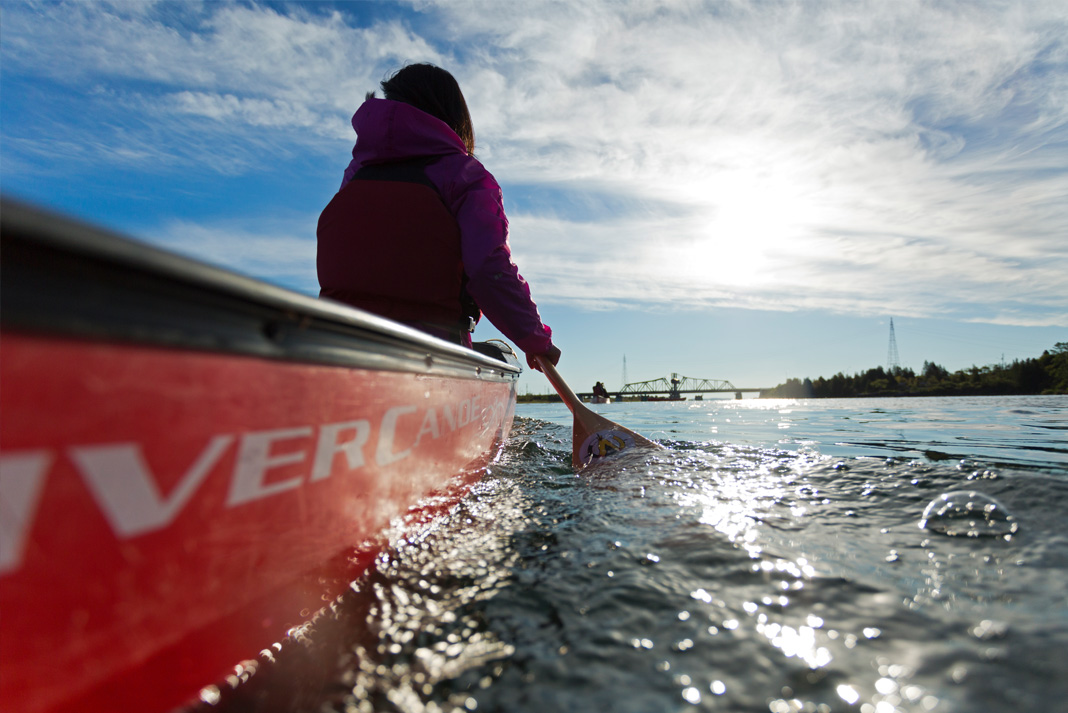
Canoeing on different bodies of water and in different conditions
How to canoe a river
One of the great joys of a canoe is exploring a river in one. But there are some things you’ll need to know to do so safely. In an ideal situation, you always know what’s downstream; is there a log jam, waterfalls, a hydro dam? These are things you need to know when you put-in on a river. You’ll also need to be actively aware of any hazards while paddling. The bow paddler should keep an eye out for rocks, downed trees, and logs and communicate the location of these hazards to the stern paddler so they can steer the canoe clear.
If you’re on a slow, meandering river, you can sometimes paddle back upstream to your vehicle. Otherwise, you will need to leave a second vehicle at the take-out or arrange a shuttle.
How to canoe rapids
Before heading out on any river, it’s important to know what kind of features are on your route. Some rivers might have short sections of fast-moving water with small rapids that can safely be navigated by novice canoeists. Others might have more serious rapids that inexperienced paddlers should not undertake on their own. Enlisting the company of an experienced paddler or, even better, taking a course, will ensure you learn all the techniques and safety elements associated with paddling whitewater.
That being said, there are some general tips that will help you navigate those smaller rapids. First off, you should be wearing your PFD (you should be already, but it bears repeating). You’ll also want to assume a kneeling position for greater stability. Next is finding a clear path through the rapids. To do this, you’ll need to look for V’s in the water. A V that points upstream has a rock at its point, which you’ll want to avoid. A V pointing downstream shows a clear path—you’ll want to steer into the opening of the V. Keep an eye out for logs, downed trees, and any other hazards and give these a wide berth.
When going through the rapids, avoid grabbing the gunwales. Keep both hands on your paddle, and keep paddling—it’ll help you maintain your balance. If you somehow get stuck sideways up against a rock, be sure to lean into the rock to keep your canoe from flipping. You may be able to push yourself off the rock or you might have to get out. This situation can be much more serious in bigger whitewater which, again, is another reason to take a whitewater course before tackling any rivers with rapids.
How to canoe on a lake
If you’re looking for a quiet and serene experience, canoeing on a lake is ideal. Lakes provide the best place to learn to paddle a canoe and the best place to enjoy the true freedom a canoe represents. Of course, we’re not talking about the Great Lakes here; we’re talking about cottage-country lakes that are small and free of boat traffic and waves. This is a great place to practice your strokes and experiment with swaying the boat back and forth to test its (and your) stability.
There can still be hazards on a lake, such as rocks and downed trees, so it’s important to always be aware of your surroundings. It’s also a good idea to check for wind and weather warnings prior to heading out. And always wear a PFD!
How to canoe upstream
Most people don’t think paddling upstream is much fun, but sometimes it has to be done. If you have to do it, the thing to realize is that you want to be paddling directly into the current at all times. As soon as you start traveling to either side of the current, it’ll push your boat sideways and start sending you downstream. The stern paddler really needs to focus on the direction of the boat, while the bow paddler provides the majority of the power.
Other things you might like to know
How to anchor a canoe
If you just want to sit still and maybe make a few casts with a fishing rod, then you’ll need to anchor your canoe. River anchors between eight and 15 pounds work well. Two anchors, one dropped off the bow, the other off the stern, will help stabilize the boat and minimize drift. Use a quick-release knot to tie the anchors to your canoe grab handles or thwarts.
How to line a canoe
Sometimes you’ll find sections of river that are beyond your comfort zone to paddle. At these spots you have two options: portage the boat and all your gear, or line the canoe. Lining a canoe involves tying a rope to both the stern and the bow of the boat. With one paddler holding each rope, they walk along shore, gently guiding the canoe through the water. It’s a technique that gets easier with practice and can save you a ton of portaging pain.



